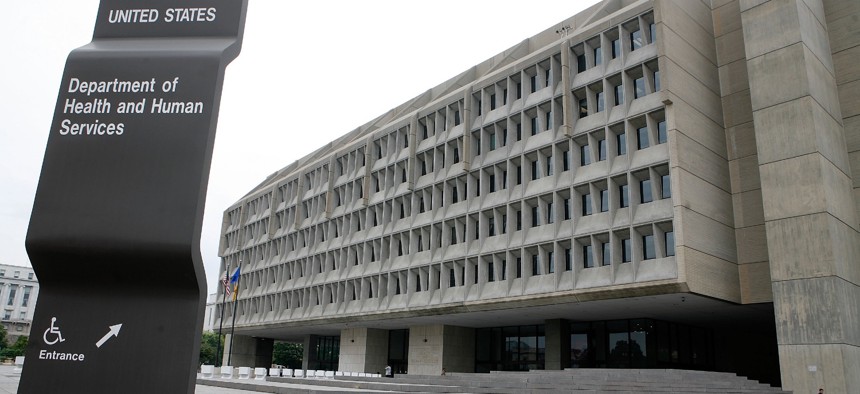
Cost estimates for Health and Human Services' deferred building maintenance and repairs backlogs rose 92% between fiscal 2017 and 2022, according to the GAO. Alex Wong / Getty Images
Federal buildings’ deferred maintenance costs are soaring, GAO says, here’s how agencies can help
The cost of delayed repairs to federal facilities swelled 58% between fiscal 2017 and 2022, and the watchdog said that agencies can be doing more to inform about the backlog.
Costs for the backlog of delayed maintenance and repairs to federal buildings have grown exponentially over the past five years, a Government Accountability Office report has found.
The Thursday report outlined a $22 billion rise in the cost estimates of deferred maintenance and repairs backlogs at four federal agencies from fiscal 2017 to 2022, finding that work originally put off because of funding constraints had swelled as high as 126% for the General Services Administration alone.
The $22 billion increase in DM&R estimates at the departments of Energy, Health and Human Services, Interior and the GSA —the principal manager of the federal government’s real estate portfolio — accounted for more than 75% of the total civilian increase of $29 billion during that five-year period. The total backlog for DM&R estimates at civilian agencies now sits $80 billion, as of fiscal 2022.
GAO said agency officials pointed to challenges like funding constraints and inflationary pressures at the root of the surging estimates, alongside other factors like increased costs of labor and materials.
“Specifically, we estimate that inflation from fiscal years 2017 through 2022 effectively eroded the purchasing power of maintenance and repair funding by about 26%, particularly in the past several years,” the report said. “Put another way, $1 million in funding in fiscal year 2022 would only accomplish what $740,313 would have accomplished in fiscal year 2017.”
Another challenge is the difficulty of managing maintenance for the federal government’s large and aging real property portfolio, which the report estimates includes 58,000 buildings with an average age of 49 years and 96,000 structures with an average age of 42 years at the four selected agencies alone.
While agency officials pointed to flat repair funding during the period and the difficulty of overseeing aging buildings, GAO also noted that the agencies may not offer all of the requisite information needed to Congress to secure the resources that could be applied to the DM&R backlog.
The report said that agencies effectively communicate their DM&R figures through “unaudited required supplementary information in annual financial reports, budget justifications or other documents,” but should also provide information reasons for cost estimate changes from the prior year, the categories of assets are included or excluded and the proportion of estimates related to critical projects needed to support agency mission.
GAO officials said the GSA, HHS and Interior currently do not include the factors driving the rise in their cost estimates, such as inflationary pressures, in their public documents, offering little context for annual increases of more than 30% at GSA and double-digits at HHS.
Interior and GSA also did not report methodological changes for calculating their estimates increased them by 40% in fiscal 2021 and 30% in fiscal 2019 and 2020, respectively.
“While these methodological changes likely contributed to improving the quality of DM&R estimates, neither of the agencies explained the changes in budget materials provided to Congress,” the report said. “As a result, it was unclear that the reasons for substantial increases in the agencies’ reported DM&R were based on changes to methodologies used to estimate DM&R rather than changes in the physical condition of the assets.”
The agencies also varied in reporting the categories of DM&R estimates included, such as the historical or cultural significance of assets, whether inactive or excess assets were included in their assessments and whether the improvements were typically included.
GAO said agencies also need to distinguish whether DM&R estimates are crucial for supporting agency mission or are less urgent, citing one example within the Energy Department where Brookhaven National Laboratory deliberately deferred all but essential maintenance to a retired steam plant building slated for demolition.
The watchdog offered 12 recommendations to the four agencies, including more public information on DM&R backlogs such as explanations for annual changes and identifying funding and time frames for reducing backlogs.
For HHS, Interior and Energy, the report recommended evaluating the cost and benefits of deploying models to analyze investment outcomes and tradeoffs.
GAO also recommended that the Office of Management and Budget update its guidance on DM&R reporting to include more information.
GSA, HHS and Interior officials agreed with the recommendations and are developing plans to address them. Energy officials neither agreed nor disagreed with the recommendations, but said they would establish a working group to examine them before developing plans to address them.
NEXT STORY: USPS looks to raise rates for packages, too







